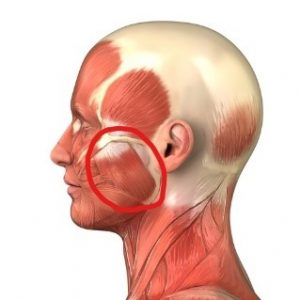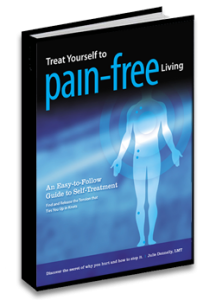Your Masseter Muscle Can Cause TMJ Pain
Author: Julie Donnelly, LMT –The Pain Relief Expert
Editor: Dr. Steve Chaney
 Do you chew gum? Do you habitually clench your teeth? Do you grind your teeth while you’re sleeping? If you do, then this article is especially relevant to you! You’ll want to pay attention to learn about TMJ pain treatment.
Do you chew gum? Do you habitually clench your teeth? Do you grind your teeth while you’re sleeping? If you do, then this article is especially relevant to you! You’ll want to pay attention to learn about TMJ pain treatment.
Your masseter muscle (circled on graphic) originates on your cheekbone and inserts into your jawbone. When this short but very powerful muscle contracts, it draws your back teeth together so you can chew your food or clench your teeth.
When all is well and the muscle is functioning properly, the muscle lengthens while you put food into your mouth, and then contracts to enable you to chew the food. However, if you chew gum or clench your teeth, you are shortening the muscle without the balancing stretch of the fibers. This is a key cause of TMJ disorder, a painful condition that causes jaw pain and causes your jaw to shift to one side when you open your mouth.
[In case you were wondering, TMJ stands for temporomandibular joint. You have one on either side of your jaw connecting your jawbone to your skull. Your TMJs act as sliding hinges, allowing you to open and close your mouth and move your jaw from side to side.]
It’s Not Just a Minor Problem – It Can Be a Very Major Situation
Too often people think this is just a painful, but minor condition. However, it can become serious, especially if you chew gum or clench your teeth.
 Several years ago, a medical doctor asked me to see a young patient who was in his office to get medical clearance before having her masseter muscle severed. Her jaw was locked tight and the oral surgeon was concerned that if she got sick and regurgitated that she would choke to death. As a result, he was planning on severing the muscle the following day.
Several years ago, a medical doctor asked me to see a young patient who was in his office to get medical clearance before having her masseter muscle severed. Her jaw was locked tight and the oral surgeon was concerned that if she got sick and regurgitated that she would choke to death. As a result, he was planning on severing the muscle the following day.
If this happened, the young woman would lose the ability to shut her mouth, and she would be drooling for the rest of her life! This was a terrible situation! The doctor felt her masseter muscle and it felt like she had nuts packed in both of her cheeks. He told her he wouldn’t sign the clearance papers until she saw me to release these tight muscle spasms.
The following treatment took only 15 minutes to accomplish the task of releasing the muscles. I spent most of the time teaching her how to do this self-treatment, and when she was told to open her mouth slowly, she did it. She was so relieved that she burst out crying. Surgery was prevented and the young woman was able to open and close her mouth easily.
Just 15 minutes of this TMJ pain treatment saved her from spending the rest of her life with her mouth open and drooling. Amazing!
Why the Masseter Muscle Can Cause Arthritis in Your Jaw
It’s all about wearing down the bone. For example, if your masseter on your right side is very tight, each time you open your mouth wide enough to put food into your mouth the muscle won’t release. As a result, your left jaw is open normally, but your right jaw isn’t. As a result, your jaw gets pulled toward the right, rubbing across the jaw bones.
Eventually, just as water will wear down a rock, your jaw constantly rubbing across the joint will wear down the bone. This will cause arthritis and other pains.
TMJ Pain Treatment for Your Masseter Muscle
 Put your fingers across your masseter muscle as shown in the picture to the left.
Put your fingers across your masseter muscle as shown in the picture to the left.
If you clench your teeth, you’ll feel the muscle bulge under your fingertips.
To make this easier to understand, we’ll start with your right fingers. Begin treatment by pressing your right fingers deeply on the right side only, just resting your left fingertips on the left masseter muscle. Hold the pressure for 15 seconds and gently release.
Next, press your left fingers deeply into your left masseter muscle and hold for 15 seconds.
Continue going back and forth and when you don’t feel pain anymore, then search the muscle for other painful points (they will feel like small peas) and repeat. You may, or may not, find multiple spasms; treat each one individually.
Continue doing this until both muscles are pain-free. Then press deeply into both sides at the same time. Slowly open your mouth as wide as you can – you are now stretching the masseter muscle.
Muscle memory is probably happening with these muscles, so I suggest you do this several times a day until you can’t find any more spasms. At that point, your masseter muscles are released and the TMJ pain treatment has been successful.
Final Thought
If you are under a stressful situation, it’s worthwhile to spend a bit of time treating these muscles, even if you aren’t feeling pain. It’s common for a person under stress to be clenching their teeth, and “an ounce of prevention is worth a pound of cure.”
 Why stay in pain when it’s so easy to find the muscular source of the problem and eliminate it?
Why stay in pain when it’s so easy to find the muscular source of the problem and eliminate it?
Treat Yourself to Pain-Free Living is filled with over 100 pictures and descriptions proven to show you how to find and self-treat muscle spasms from head to foot!
Join the 1000’s of people worldwide who have discovered that tight muscles were the true source of pains they thought were from arthritis, fibromyalgia, and other serious conditions. You have nothing to lose, and everything to gain by releasing tight muscles.
Treat Yourself to Pain-Free Living is your step-by-step guide to pain relief!
Wishing you well,
Julie Donnelly
These statements have not been evaluated by the Food and Drug Administration. This information is not intended to diagnose, treat, cure or prevent any disease.
About The Author
 Julie Donnelly is a Deep Muscle Massage Therapist with 20 years of experience specializing in the treatment of chronic joint pain and sports injuries. She has worked extensively with elite athletes and patients who have been unsuccessful at finding relief through the more conventional therapies.
Julie Donnelly is a Deep Muscle Massage Therapist with 20 years of experience specializing in the treatment of chronic joint pain and sports injuries. She has worked extensively with elite athletes and patients who have been unsuccessful at finding relief through the more conventional therapies.
She has been widely published, both on – and off – line, in magazines, newsletters, and newspapers around the country. She is also often chosen to speak at national conventions, medical schools, and health facilities nationwide.
